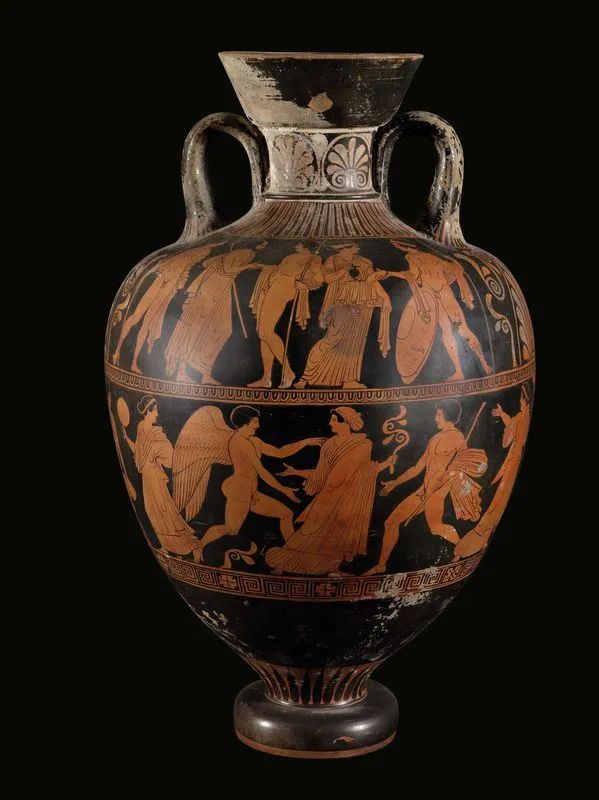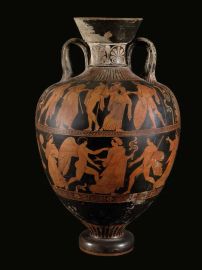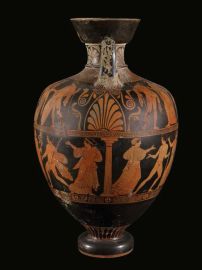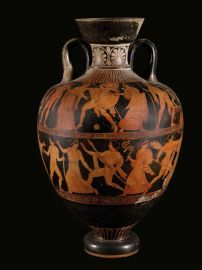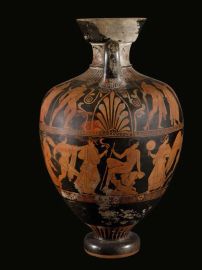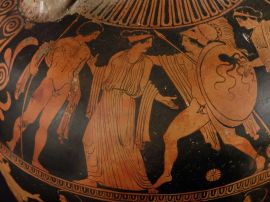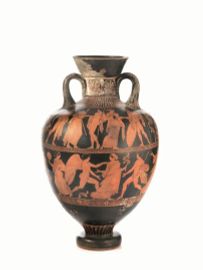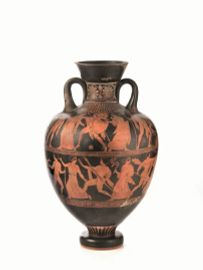Amykos Painter
(active 430-410 BC)
LARGE RED-FIGURE PSEUDO-PANATHENAIC AMPHORA, LUCANIAN
Orange clay, black, white, and yellow paint, orange colouring, modelled on a fast lathe. Tall reverse tapered nozzle, tapered concave profile neck with moulded ring, oblique shoulder, ovoid body with elongated lower extremity, ribbon handles attached from the base of the neck to the shoulder, echinus-shaped foot. Height 68 cm, diameter at the hem 18.9 cm
This find has been declared of cultural interest in accordance with the D. LGS 42/2004.
Accompanied by a letter written and signed by A. D. Trendall attributing the piece to the Amykos Painter, dated March 2nd 1965, and by a thermoluminescence certificate from Arcadia – Milan dated February 2016
The vase’s the elongated lower section and the bottom of the foot are executed in relief; the neck features a chain of small seven-leaf fan palmettos framed by gyrals; on the shoulder and at the base of the handles we find a faux-fluted motif; beneath the handles there is a large fan-shaped eleven-leaf palmetto in between two pair of gyrals and flower motifs; beneath the first series of figures we find a ionic kyma, beneath the second a right-bearing meander, interrupted by a cross motif; on the foot conjunction we find a sunburst motif.
The decoration is divided into two superimposed bands, divided up between the two sides. Side A: on the shoulder we find the figure of a naked warrior, seen from the side and leaning to the right, wearing a long-crested Corinthian helm raised on the forehead, a draping himation on the shoulders which runs down to the forearms, together with a long spar and circular shield bearing the image of an octopus with moving tentacles. The young man is shown between two maidens, dressed analogously and wearing a tainia in their curly hair, a pleated peplum held in place on their shoulders by two fibulae and by a belt on their waist, a draped himation over the shoulders and the arms, which move one to the right and the other to the left. The scene is completed on the sides by two naked young man bearing a spear, and wearing a himation over their forearms; one of the two is also wearing a cone-shaped helm; both youths are looking towards the central figure.
Side B: scene from a gymnasium, with at its centre a naked youth, turned to the right, wearing draped himation on his forearms and bearing a long spear in his left hand, he is about to shake hands with the pedagogue, shown to be old and bald, and who in turn is turning to the left towards the youth, with part of his naked chest revealed by the chiton, and holding a long T-shaped stick in his left hand. Behind him we see another naked youth, turning by three quarters to the left, with a pair of spears in his left hand and the right foot boldly represented in perspective. On the opposite side of the scene we find a facing pair featuring a male athlete and a young woman wearing a pleated peplum and holding a small oinchoe in her right hand, which she using to pour wine into the patera which the young man is holding out to her. The athlete is, as is customary, depicted in the nude, with a tainia on his head, a himation over his forearms, a spear in his left hand and a large circular shield resting on the ground and on his groin.
In the lower band, starting from a Doric column situated below one of the handles, and which is meant to recall the trabeation of a building, we see a complex scene unfolding, in which male figures of naked athletes with draped cloaks over their arms or carrying spears and clubs in their hands are shown chasing a group of young women wearing pleated peplums and tainias, some of whom are also carrying plants in their right hand. At the centre we see a naked and winged cupid-like figure, who turning to the left is running after a young girl carrying a plant in her left hand; below one of the handles we see a naked young man sitting down on a rock on the right and looking behind him, with a stick in his right hand, he is looking at a woman who is moving towards him with a mirror in her right hand.
Fitting comparisons can be made in terms of shape and decoration with a panathenaic amphora held in Naples (inv. 2416 and 2418), and with another one held in Munich (inv. 3275).
Condition: whole, some incrustation, minor nicks.
The Amykos Painter, who operated during the final thirty-odd years of the 5th century BC, is the most important of the proto-Lucanian painters, as declared by A.D. Trendall, the most influential student of Magna Graecia ceramography. The vases produced by this painter known to us today are almost 250, and have been found all across Italy, from Syracuse to Marzabotto, but we know of some vases coming from as far as Albania.
It is thought that the painter was born in Athens, were he began his activity of ceramography, and that he later moved to Magna Graecia, probably to Metaponto, where he continued to work under the guidance of the Painter of Pisticci.
The first phase of the painter’s production, in terms of style and content, was very close to the work of the Painter of Pisticci, so much so that it is often difficult to tell the two apart. Later on, the work of the Painter of Amykos began to find a more marked individuality, developing his own mannerism and departing from original attic models. The frequent scenes depicting amorous chases and bearing a decidedly Dionysiac character feature female figures that are slender and stiff in their clothing, as is the case with the present amphora.
The later production of the Painter of Amykos shows how much he departed from the style of the Painter of Pisticci. However, between his last and first work we nonetheless find an uninterrupted continuity, so much so that Trendall argued that the Painter of Pisticci and that of Amykos were really two phases in the work of a single person; given the current state of research on the matter, however, we do not have the material elements necessary to assert with certainty that the vases of the Painter of Pisticci are the first works of the Painter of Amykos.
The eponymous vase of the Painter of Amykos is a wonderful hydria held in Paris in the Cabinet des Médailles (inv. n. 442) (figg. 1-2) which depicts the giant Amykos tied to a rock, surrounded by Medea and the Argonauts together with satyrs and maenads, the painter’s favourite figures.
According to the Greek legend, Amykos was the son of Apollo and of nymph of Bithynia, and was the king of the Bebryces. Amykos would not let any foreigners land on his domains or draw from the spring near the harbour, unless they first bested him at a boxing match. When the Argonauts landed, however, he was beaten by Pollux, and then tied up or, according to some versions of the myth, killed. The invention of the leather band boxing gloves used by the Greeks was traditionally attributed to the giant.
Comparative literature
N. Moon, in Papers of the British School at Rome, XI, 1929, p. 37;
C. Watzinger, in Furtwängler-Reichhold, III, 1932, pp. 346 ss.;
F. Magi, in Rendiconti della Pontificia Accademia Romana di Archeologia, XI, 1935, p. 119 ss.;
A. D. Trendall, Frühitaliotische Vasen, Lipsia 1938, pp. 12 ss.;
A. D.Trendall, Handbook to the Nicholson Museum, Sydney 1948, pp. 317 ss.;
A. D.Trendall, Vasi antichi dipinti dal Vaticano: Vasi italioti ed etruschi a figure rosse, Città del Vaticano 1953, pp. 2 ss;
A. D.Trendall, A. Cambitoglou, The Red-figured Vases of Lucania, Campania and Sicily II, Vol. I, Oxford 1967, p. 45 n. 218a;
A. D.Trendall, Red-figured Vases of South Italy and Sicily, London 1989, pp. 20-21 nn. 11-19

